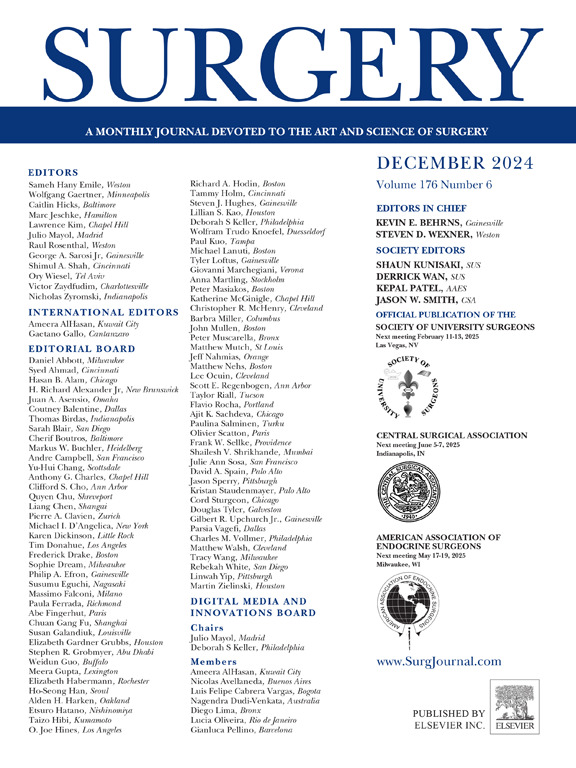Prognostication with Thyroid GuidePx in the context of tall cell variants
IF 3.2
2区 医学
Q1 SURGERY
引用次数: 0
Abstract
Background
The tall cell variant of papillary thyroid cancer generally has a worse prognosis compared with the classical variant. Thyroid GuidePx is a genomic classifier capable of classifying papillary thyroid cancer into 3 molecular subtypes using fine-needle aspirate. Type 1 and 2 have low recurrence rates, particularly in early tumors (1–4 cm and N0). Type 3 is characterized by aggressive biology and high recurrence rates regardless of size and lymph node status. The study examines the interaction of tall cell variant histology with Thyroid GuidePx risk stratification.
Methods
Gene expression data from 736 patients (The Cancer Genome Atlas, Canada, and South Korea), were submitted to the Thyroid GuidePx classifier. Results across the 3 molecular subtypes were further dichotomized into “early” papillary thyroid cancer (tumor size 1–4 cm and N0) (n = 369; 51%) or “advanced” papillary thyroid cancer (n = 359; 49%). Structural recurrence was the primary outcome measure in our analysis. Transcriptomic and genomic analysis was conducted to explore what biological differences could account for clinical differences between tall cell variant and non- tall cell variants.
Results
Thyroid GuidePx identified 369 early papillary thyroid cancers: 129 (35%) type 1, 168 (45.5%) type 2, and 72 (19.5%) type 3. The recurrence rates for early type 1, type 2, and type 3 papillary thyroid cancers were 3.9%, 1.9%, and 19.4%, respectively. There were no type 1 tall cell variants. In type 2 papillary thyroid cancers, the incidence of tall cell variant was greater in advanced than early papillary thyroid cancers (10.2% vs 4.2%, P = .04). Notably, none of the 7 early type 2 tall cell variants recurred. In type 3 papillary thyroid cancers, the prevalence of tall cell variants was similar in early and advanced tumors (10% vs 9%, NS). When compared with non-tall cell variants, early type 3 tall cell variants trended toward greater recurrence (28.6% vs 18.5%, not significant) whereas advanced type 3 tall cell variants had a significantly greater recurrence rate (50% vs 28.6%, P = .01). Biologically, type 3 tall cell variants had had a pronounced enrichment in cell proliferation, epithelial-mesenchymal transition, invasion, and inflammation.
Conclusion
Thyroid GuidePx reliably identifies a low-risk subgroup (early type 1 and early type 2 papillary thyroid cancers) for which conservative procedures would be appropriate. Tall cell variants in this subgroup are uncommon (1.2%), and none of the tall cell variants in this subgroup recurred. Type 3 papillary thyroid cancers have greater recurrence rates in both early and advanced papillary thyroid cancers. Tall cell variant appears to further increase recurrence in this subgroup.
在高细胞变异的背景下使用甲状腺 GuidePx 进行诊断。
背景:甲状腺乳头状癌的高细胞变异型通常比传统变异型预后更差。Thyroid GuidePx是一种基因组分类器,能够利用细针穿刺将甲状腺乳头状癌分为3个分子亚型。1型和2型的复发率较低,尤其是早期肿瘤(1-4厘米和N0)。3型的特点是具有侵袭性生物学特性,无论肿瘤大小和淋巴结状态如何,复发率都很高。本研究探讨了高细胞变异组织学与甲状腺导Px风险分层的相互作用:方法:将736名患者(加拿大和韩国的癌症基因组图谱)的基因表达数据提交给甲状腺GuidePx分类器。3种分子亚型的结果被进一步分为 "早期 "甲状腺乳头状癌(肿瘤大小为1-4厘米且N0)(369人;51%)或 "晚期 "甲状腺乳头状癌(359人;49%)。结构性复发是我们分析的主要结果指标。我们还进行了转录组和基因组分析,以探讨高细胞变异型与非高细胞变异型之间的临床差异是由哪些生物学差异引起的:Thyroid GuidePx确定了369例早期甲状腺乳头状癌:129例(35%)为1型,168例(45.5%)为2型,72例(19.5%)为3型。早期1型、2型和3型甲状腺乳头状癌的复发率分别为3.9%、1.9%和19.4%。没有1型高细胞变异。在2型甲状腺乳头状癌中,晚期甲状腺乳头状癌的高细胞变异发生率高于早期甲状腺乳头状癌(10.2% vs 4.2%,P = .04)。值得注意的是,7例早期2型高细胞变异均未复发。在3型甲状腺乳头状癌中,高细胞变异在早期和晚期肿瘤中的发生率相似(10% vs 9%,NS)。与非高细胞变异型相比,早期3型高细胞变异型的复发率更高(28.6% vs 18.5%,无显著性差异),而晚期3型高细胞变异型的复发率明显更高(50% vs 28.6%,P = .01)。从生物学角度来看,3型高细胞变体在细胞增殖、上皮-间质转化、侵袭和炎症方面具有明显的富集性:甲状腺GuidePx能可靠地识别适合保守治疗的低风险亚组(早期1型和早期2型甲状腺乳头状癌)。该亚组中的高细胞变异并不常见(1.2%),而且该亚组中的高细胞变异无一复发。在早期和晚期甲状腺乳头状癌中,3型甲状腺乳头状癌的复发率都较高。高细胞变异似乎会进一步增加该亚组的复发率。
本文章由计算机程序翻译,如有差异,请以英文原文为准。
求助全文
约1分钟内获得全文
求助全文
来源期刊

Surgery
医学-外科
CiteScore
5.40
自引率
5.30%
发文量
687
审稿时长
64 days
期刊介绍:
For 66 years, Surgery has published practical, authoritative information about procedures, clinical advances, and major trends shaping general surgery. Each issue features original scientific contributions and clinical reports. Peer-reviewed articles cover topics in oncology, trauma, gastrointestinal, vascular, and transplantation surgery. The journal also publishes papers from the meetings of its sponsoring societies, the Society of University Surgeons, the Central Surgical Association, and the American Association of Endocrine Surgeons.
 求助内容:
求助内容: 应助结果提醒方式:
应助结果提醒方式:


